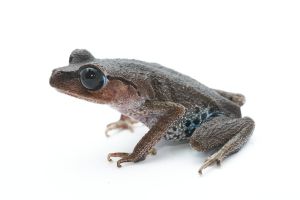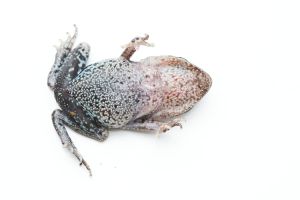
Frogs of Borneo

Frogs of Borneo

Frogs of Borneo

Frogs of Borneo

Frogs of Borneo

Frogs of Borneo

Frogs of Borneo

Frogs of Borneo

Frogs of Borneo

Frogs of Borneo

Frogs of Borneo
Bornean Families
Leptobrachium:
kanowitense
Kanowit Black-eyed Litter Frog
Leptobrachium kanowitense was formerly known as L. nigrops. The latter has been split up into L. ingeri and L. kanowitense. L. kanowitense is a species of lowland rainforests in inland areas of Sarawak. Leptobrachium kanowitense is differentiated from L. ingeri by less developed toe webs and by having less pointed finger tips. L. kanowitense has dark blotches only at the groin and posterior thigh; the thigh is whitish ventrally with some dots.The tympanum is uniformly colored. The dorsum lacks the markings seen in L. ingeri.
Leptobrachium kanowitense is a small species of Leptobrachium, closely related to L. ingeri and L. nigrops. Adult females have a snout-vent length (SVL) of 39–45 mm, while the known male measures 33 mm. The fingertips are pointed but less so than in L. ingeri. The toe webbing is much less developed than in L. ingeri. The eardrum (tympanum) is visible and uniformly brown (not black). The back (dorsum) is uniformly brown without any distinct markings. The sides of the body are light brown with a few small dots near the groin area. The underside (ventrum) is mostly whitish, with black dots concentrated on the belly and throat. The chest and the underside of the limbs are whitish with only a few black spots. There are thin black bars on the upper surface of the limbs, including the fingers and toes. The only prominent patterns are found at the groin and the back of the thighs, where clear markings are present. The underside of the thighs is whitish, also with some scattered dots. The femoral glands are large and appear as a noticeable white patch. The call is a series of 5–10 notes.
We tentatively assign the specimen on the photos from Gunung Sebako, western Sarawak, to L. kanowitensis. However, not all coloration features of the original description are met by this specimen and we certainly have to learn a lot about the regional variation of L. ingeri and L. kanowitensis.
Version tracking
-
30.07.2025
updating images and text

